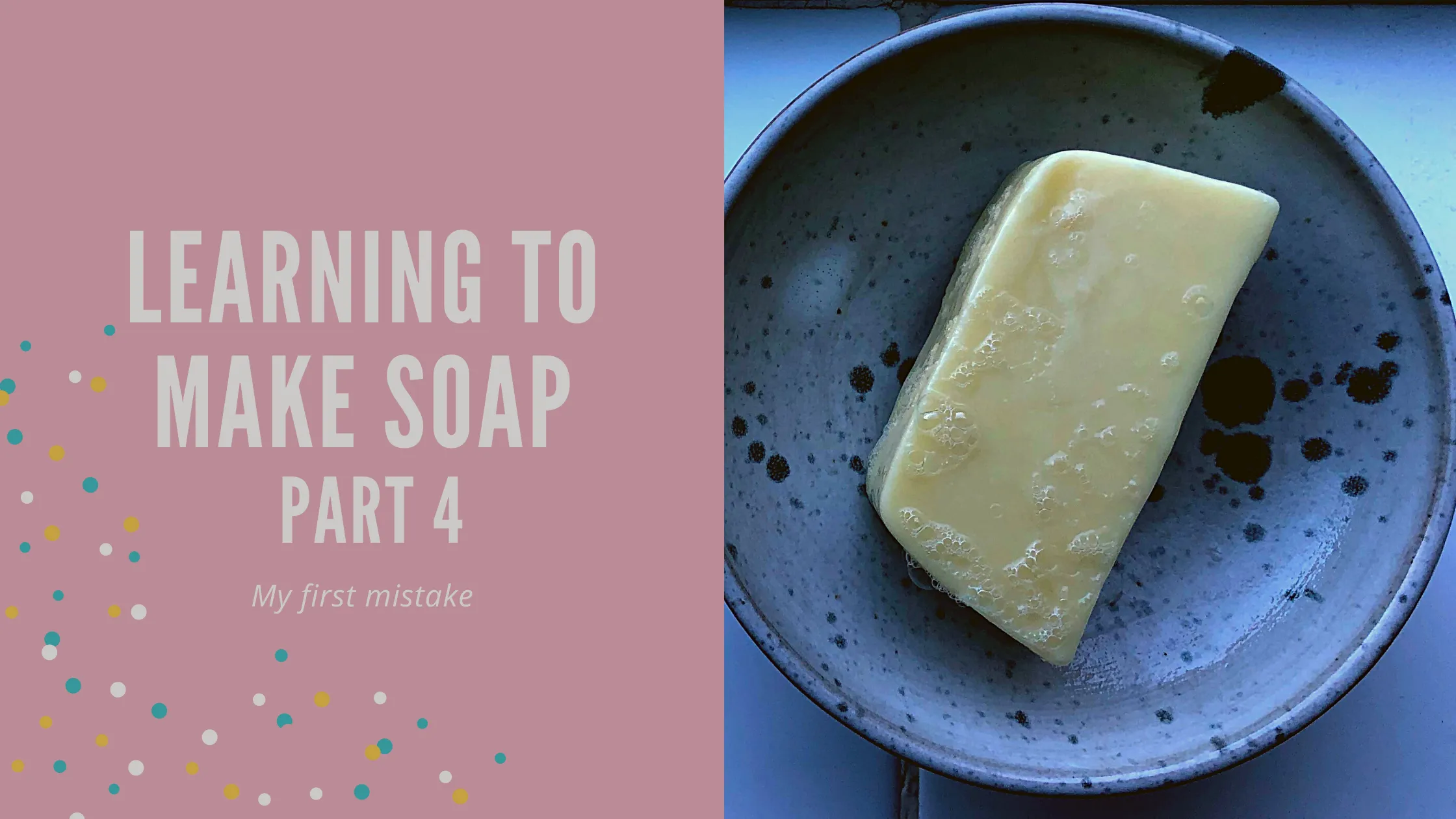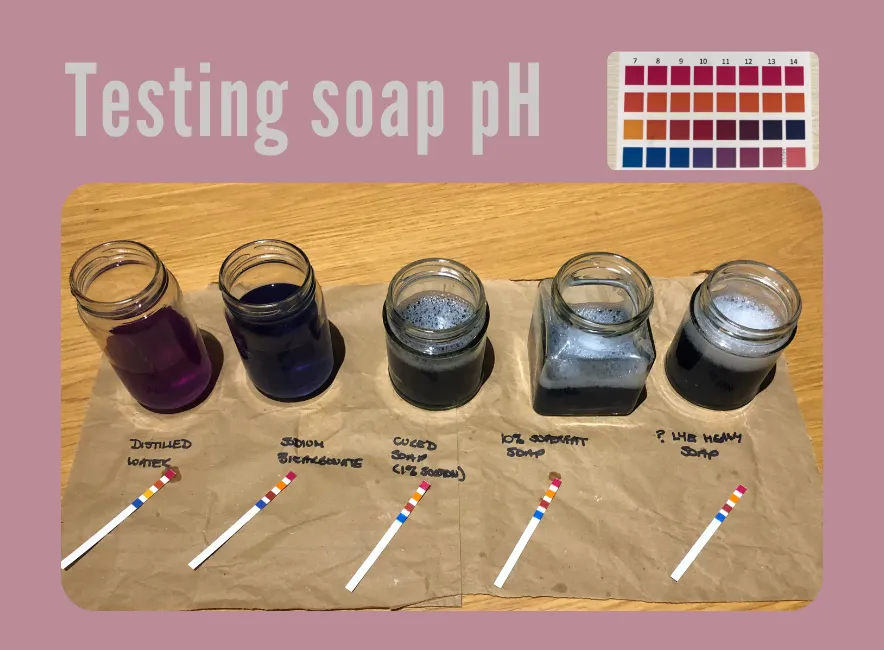Learning to Make Soap: Part 4
My First Mistake

Following the spider incident, I was really pleased when my castor oil arrived and I was able to get soap making. I was trying two of my newly designed Small Kindness recipes (5% superfat, Palm oil free with both Shea and Cocoa butter as well as coconut, olive and sunflower oil with castor oil to boost the bubbles).
I also wanted to continue my experimentation with scent so I was also going to try out a couple of simple essential oil blends too (Rosemary and Lavender, Ginger and Mandarin) - just to see how they come through the soaping process and how strong the scents were.
As mentioned in my Learning to make soap part 2 blog post I am using a 33% Lye solution and a cool soaping temperature of 40°C with the theory being that these soaps would be slow to saponify and would not go through gel phase. As I was making 2 different batches I decided to make up my 33% Lye solution for both batches together. Although this makes perfect sense and is standard bench science practise, what hadn’t really occurred to me was that I don’t have enough containers to measure out the lye solution for each batch separately.
This is what ultimately resulted in my first big soap making mistake! Long story short and following a disagreement with my scales (which decided to turn off mid weigh!!), I added too much of the 33% lye solution to one batch and too little to the other. Classic newbie error. Although I was well aware of my mistake, I carried on and finished making the soaps and poured them into their moulds (a Tetra Pak and a lined takeaway container). But as soon as I had finished I set to working out what soap I had actually made.
It turns out one batch was now 10% superfat – which, in reality, isn’t a disaster and will give me the chance to see how different a 10% superfat soap is to a 5% superfat soap. If I prefer the higher % superfat it means at least for this batch, my mistake was serendipitous. And when it comes to scent, this batch was Rosemary and Lavender which smells really amazing – a little bit strong currently (although not enough for a migraine) but I will have to see how it smells after curing as I am fairly sure it will fade. But I am totally loving it!
Unfortunately the other batch is probably going to be lye heavy or 1-2% superfat at best. Gutted. And the essential oil blend for this soap didn’t come through the soaping process that well either. All in all, not my most successful soap making experience.
If the soap turns out to be lye heavy then we won’t be able to use it. But before I repurpose this soap as laundry soap (no waste here!) I need to test the pH to determine if the soap is indeed lye heavy. Generally speaking soap is alkaline and should have a pH some where between pH 8-10. Anything higher than that will irritate the skin (definitely not what I am going for!). There are a number of ways to test this – you could use the zap test (aka put your tongue on the soap and see if you get a 'zap', if you do it is lye heavy). I am not overly keen on the sound of this method (although my stepkids are!). In addition to this a number of soaping websites recommend using a pH indicator made from red cabbage, or I could test the pH of the soap using pH indicator paper. In the end I decided to use both the pH indicator paper and the indicator from the red cabbage as I haven’t done that before and to be honest it sounds like fun.
So can we really use red cabbage to test pH? Well the short answer is yes! Red cabbage gets its colour from compounds called anthocyanins and anthocyanins are pH sensitive. In acidic conditions, anthocyanins appear red, in neutral conditions (like distilled water, pH 7) they are purple and in alkaline solutions (like soap, pH 9) they are blue. And as it turns out, making a pH indicator from red cabbage is super easy! Just blend up 1/8 of the cabbage with distilled water and drain through a sieve, keeping the liquid as this will be your pH indicator. If you are unsure there are loads of good videos on Youtube. The pH indicator paper I have chosen to use has 4 different indicator pads on each strip to make the determination of pH as accurate as possible as it can be notoriously difficult to get an accurate measurement using standard litmus or indicator paper.
Next it was time to set up the experiment! To test the pH of the soaps I made a 1% solution (1g of soap dissolved in 99g of distilled water) and for completeness I decided I would test a cured soap alongside the 10% superfat soap and the possible lye heavy soap (?lye heavy). I also made up a solution of sodium bicarbonate (pH 8.2) and distilled water (pH 7) as controls.
First, to test the pH I submerged the indicator paper in the solution for 2 seconds and then following 4 seconds I compared to the colour chart. As you can see from the photo below, the distilled water measured a pH 7, sodium bicarbonate measured a pH8 and the cured soap measured pH 9. So far so good! But what about the soaps where I had added the incorrect amount of the Lye solution?
Much to my relief both were pH 9 too. Just to be on the safe side (and because I had never done it before and was interested to see how it would work) I also tested the pH using the indicator solution made from red cabbage. To do this I just poured some of the cabbage indicator solution into the controls and 1% soap solutions. This confirmed what the universal indicator paper showed, which was the distilled water was pH 7 (solution remained purple), Sodium bicarbonate was pH 8 and all the soaps I had made were around pH 9.

I know that the potentially lye-heavy soap might still be quite drying due to the minimal superfat but at least I know it is safe to use. I really enjoyed testing the pH of the soaps, and I am super relieved that the soap I had made didn’t end up being unusable – but now I must get back to remake (correctly this time) my Small Kindness soaps. As always I will be back next week to report back on how it is all going.
...
I am Kelly Townsend and this is the Small Kindness Blog. I am a scientist, a bee lover, a rewilding obsessive, and I want to spread Small Kindnesses through the medium of soap. Follow me on Facebook, Instagram and Twitter for your daily dose of kindness (as well as to see how the soap making is going!)
